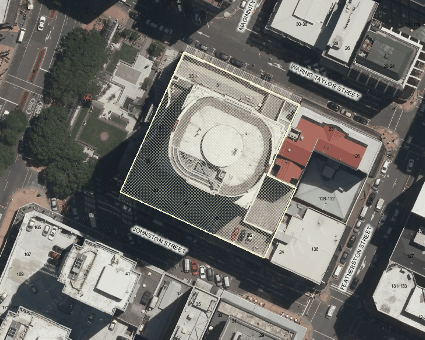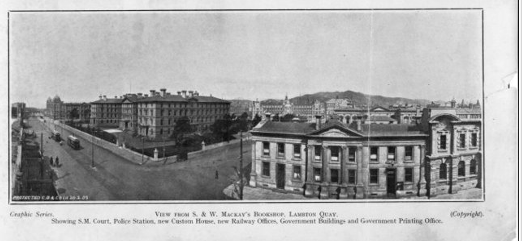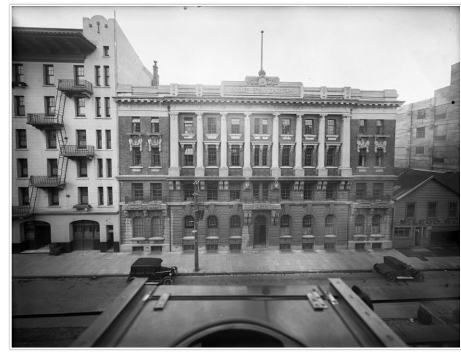Former Central Police Station
Mobil on the Park Building, Vodafone on the Quay Building, Midland Parking Building

Photo: WCC - Charles Collins, 2015


Lambton Quay, Wellington. C B and Company Ltd : Photographs from the publication "Panoramic photographic pictures of Wellington and vicinity". Ref: 1/2-031332-F. Alexander Turnbull Library, Wellington, New Zealand. http://beta.natlib.govt.nz/records/22708895

Police headquarters (later the Central Police Station), Johnston Street, Wellington. Smith, Sydney Charles, 1888-1972 :Photographs of New Zealand. Ref: 1/1-024870-G. Alexander Turnbull Library, Wellington, New Zealand.http://beta.natlib.govt.nz/records/23240055
-
Constructed
1913 - 1917
-
-
Architect(s)
-
Builder(s)
-
The former Central Police Station is a fine Edwardian Baroque building that has been much altered by the insertion of multi-storey office building on the site.
The remaining fragments of the old police station continue to have aesthetic value for the stylised decorative ornamentation on the carefully proportioned Classical façades to Brandon and Johnston Streets.
The building has a strong historic association with the New Zealand Police, as the capital’s Central Police Station for over 70 years, and the National Police Headquarters for 50.
-
Downloadable(s)
-
close
History
-
The former Wellington Central Police Station was constructed in 1914-17 on the site of the Theatre Royal, with a street façade to both Waring Taylor and Johnston Streets. The site was part of the 1866-7 Provincial Government reclamation that created the land between Lambton Quay and Customhouse Quay from approximately Grey Street to Waring Taylor Street.
The Central Police Station was originally situated on Lambton Quay on the site of the current Supreme Court, but the building was considered overcrowded and the government secured the site of the old Theatre Royal when it was demolished in c.1913. Although the Theatre Royal had been a popular attraction when it opened at the Odd Fellows Hall in 1865 and moved into its purpose built theatre in 1874, patronage had dwindled at the end of the nineteenth century. The theatre had a brief renaissance with the introduction of vaudeville-style shows, but by 1913 the venue was thought to be old fashioned and surplus to need, particularly with the construction of the new, modern, Opera House on Manners Street.
The new police station was designed by John Campbell the Government Architect as both a police station and National Police Headquarters. The foundations were constructed as day-works presumably under the supervision of the district engineer J.D. Louch in 1914, and the contract for the remainder of the works were let to Trevor Brothers of Wellington and Palmerston North for approximately £37,000 in 1915. The project was delayed by the lack of availability of building materials and manpower during WWI. Despite these setbacks the building was completed at the end of 1917 and the Central Police Station occupied the building from April 1918.
The building was styled on a Roman palazzo with a rusticated base, concrete and rendered details that were painted to resemble Oamaru stone, and pressed red facing brick that had been made in the Trevor Brothers brickwork in Rintoul Street, Newtown. It was designed around a central drill or exercise yard with two four storey blocks, one fronting Waring Taylor and the other Johnston Street. A three storey annexe spanned between the two taller buildings and housed the cell block.
The Waring Taylor Street building was occupied by the central police station. The basement housed the carpark and was accessed by a vehicular ramp from the central courtyard. The ground floor was occupied by offices and by the watch-house and offices for the sergeant in charge. The first floor housed the staff recreation facilities including a large billiards room, library and study as well as self contained accommodation for the prison matron who presumably oversaw the welfare of female prisoners. The second floor housed the gymnasium, baths, kitchen and dining hall and the third floor was divided into bedroom “cubicles” as living accommodation for up to 25 policemen.
The Johnston Street building was occupied on the ground floor and first floors by the National Police Headquarters including the Police Commissioner, the District Superintendant and District Inspector and their staffs, along with offices for the Police Gazette and the finger print branch. The basement was used for storage and archives, and the second and third floors were let to the National Provident Fund and to the Valuation Office.
The police station and National Police Headquarters were sited in close proximity to the courts, Parliament and the government precinct at the north end of Lambton Quay. This was not altogether advantageous as, in the early years, the accused were walked under police guard from the Central Police Station to court and back, much to the embarrassment of the guilty and not guilty alike. This was solved in 1918 by the purchase of a “Black Maria” police van that was parked in the central courtyard / basement of the station.
The first major alterations occurred in 1937 when the residential quarters were upgraded and the single men’s cubicles were demolished and replaced with 40 single bedrooms. In 1939 the government purchased the vacant timber yard to the east of the police station, presumably with the intent to extend the building, although this never occurred. The entablature and the entrance canopy to Johnston Street were removed after the Wellington/Wairarapa earthquake and the parapet was replaced by a simplified rendered band on both street facades. The National Police Headquarters moved to new offices in 1967, and a new Central Police Station opened in 1991 on Victoria Street, that was designed to withstand a major earthquake and designed to suit modern policing needs.
The site was developed in two stages by Norseman Pacific, to a design by Peddle Thorp and Montgomery Architects. The development created approximately 28,000m2 of floor area for a total cost of $45million and the main contractor was Mainzeal. Stage 1 was the partial demolition of the police station buildings and the construction of a Wellington City Council funded car park, retail units and office space behind the original facades, and it is likely that the brickwork was painted, and the extra storey added to both Waring Taylor and Johnston Street facades at this time. Stage 2 comprised the construction of a multi-storey tower block with an entrance from Midland Park (1983). The development was completed in 1999.
In 2012 ANZO (AMP NZ Office) asked their “ten office and retail tenants” to vacate the building so that it could be strengthened. The former Central Police Station buildings had been assessed as 20-33% of the current building code, and the owners planned to bring the building to 80% of the current standard at a cost of approximately $3m. The multi-storey tower was said to be a separate structure, and not affected. The work would include roof bracing, and strengthening the masonry facades, and was estimated to take 12 months to complete (including design, consents and construction).
-
Modifications
close
-
1866 - 1867
-
Reclamation from Grey Street to Waring Taylor Street.
-
1874 - 1874
-
Theatre Royal constructed on the site
-
1913 - 1913
-
Theatre Royal demolished
-
1914 - 1914
-
Foundations for the Central Police Station were constructed
-
1915 - 1915
-
Contract for the remaining works let to Trevor Brothers
-
1917 - 1917
-
In December building was complete
-
1918 - 1918
-
In April the Central Police Station moved from Lambton Quay to the new building
-
1937 - 1937
-
Works to alter and refurbish the single men’s living accommodation on the third floor
-
1942 - 1942
-
Earthquake damage to the parapet
-
1967 - 1967
-
National Police Headquarters moved out
-
1991 - 1991
-
The new Central Police Station opened on Victoria Street
-
1993 - 1999
-
Works to adapt the original police station, construct the Midland car parking building and the “Mobil on the Park” office tower.
-
2012 - 2012
-
ANZO (AMP NZ Office) asked tenants to vacate the building so that it could be earthquake strengthened
-
-
Occupation History
close
Not assessed
-
-
close
Architectural Information
-
Building Classification(s)
close
Not assessed
-
Architecture
close
The former Central Police Station was originally built as a pair of four storey plus basement buildings facing Waring Taylor and Johnston Streets with a three storey annexe building constructed to the west of the original courtyard. The police station was partly demolished in the early to mid 1990s. An extra floor was added to the Waring Taylor and Johnston Street buildings, and the remaining parts of the original interior were converted for use as retail and office space, and a car park. A multi-storey Post-Modern (PoMo) tower was constructed in the centre of the site; the original cell block annexe was replaced by a jarring PoMo entrance to Midland Park; and a modern (but sympathetically designed) car parking building was constructed to the west of the building. The addition of a sculptural glass and steel canopy at first-floor (floor) level, although not an original feature of the building, has been carefully considered, and is one of the better examples of a modern verandah on a heritage building within the CBD.
The remaining early or original building fabric is restricted to parts of the Waring Taylor and Johnston Street blocks of the Central Police Station including the facades, part of the existing concrete floors / timber floor coverings and some of the internal structural walls. The facades have been somewhat compromised by the addition of a large plain pseudo-parapet that presumably conceals a fifth floor of car parking, and by the decision to paint the facing brick in the 1990s.
These were designed by Government Architect, John Campbell, who had established Edwardian Baroque as the official “government style” for official buildings including police stations, law courts and post offices. The most notable examples of his buildings in this style were the exuberant Public Trust Building (1908) and more restrained Parliament Buildings (1912-22).
The Central Police Station was designed to resemble a Roman palazzo, and the style was possibly chosen to “stand as a civic exemplum, expressing the probity and dignity of the Law.” The Waring Taylor and Johnston Street facades are near-identical, with some minor variations to the detail of the hood mouldings over the windows; the number and placement of windows and door openings on the ground floor; and the design of the central colonnade.
The ground floor and first floor elevations on both facades are heavily rusticated, and the doors and windows on the ground floor are recessed into semi-circular segmented arched openings, with a voussoir detail, all formed in render to resemble stone. The windows on the second floor are plain and square headed. The dominant feature of the third and fourth floors was the central colonnade of rendered Tuscan pilasters that once stood in strong contrast to the pressed red facing brick of the external walls. Unfortunately the prominence of the colonnade was somewhat diminished by the decision to paint the brickwork at some time in the mid 1990s.
The colonnade projects forward onto a stylised corbelled plinth, and rises two storeys to the plain (1942) cornice. The windows hoods between third and fourth floor are interesting for their unusual stylised “Union Jack” and paterae (flat circular ornaments).
The façades are modelled in strong relief, and their regular, symmetrical design gave the building an appearance of “strength and regularity” that suit its original use as a police station. Unfortunately, the building has been compromised by the alterations of the 1990s, most of which are irreversible.
Note: The physical description is based on ‘Statement of Evidence by Chris Oarsman at the request of the NZHPT and the Wellington District Committee of the Trust to a Resource Consent Application by Norseman Pacific Limited.’ undated but assumed c.1992.
-
Materials
close
Concrete foundations, brick masonry and concrete walls, render finish.
-
Setting
close
The former Central Police Station is somewhat overwhelmed by the Post Modernist tower that sprouts from the centre of the site, utilising the original buildings as a two sides of a five-storey podium. The third side of the podium is the Post Modern elevation to Midland Park that is now the building’s main entrance.
Midland Park is a “pocket-park” bounded by a covered walkway along Lambton Quay and a series of tall “hooped” light fittings to Johnston and Waring Taylor Streets. The park landscaping includes a water feature, paving and lawn. To the south of Midland Park on Lambton Quay is another example of façade retention that is the poorly conceived development of the Kirkcaldie and Stains department store. To the north of Midland Park on Lambton Quay is the similarly scaled TSB Bank tower and podium.
-
Building Classification(s)
close
-
close
Cultural Value
The former Central Police Station is a fine Edwardian Baroque building that has been much altered by the insertion of multi-storey office building on the site.
The remaining fragments of the old police station continue to have aesthetic value for the stylised decorative ornamentation on the carefully proportioned Classical façades to Brandon and Johnston Streets.
The building has a strong historic association with the New Zealand Police, as the capital’s Central Police Station for over 70 years, and the National Police Headquarters for 50.
-
Aesthetic Value
close
-
Architectural
Does the item have architectural or artistic value for characteristics that may include its design, style, era, form, scale, materials, colour, texture, patina of age, quality of space, craftsmanship, smells, and sounds?
The former Central Police Station is a fine Edwardian Baroque building that has been much altered by the insertion of multi-storey office building on the site. Although more of the original building fabric has survived the redevelopment than the Kirkcaldie and Stains’ building that is its southern neighbour on Lambton Quay, the former police station is somewhat overwhelmed by its transformation into the podium of a much larger tower. The remaining fragments of the old police station continue to have aesthetic value for the stylised decorative ornamentation on the carefully proportioned Classical façade.
-
- Historic Value close
-
Scientific Value
close
-
Archaeological
Does the item have archaeological value for its ability to provide scientific information about past human activity?
This building is included in the NZAA Central City archaeological area. Although some of the sites have been altered by rebuilding or landscaping or sub-divisional change, there is archaeological value in the immediate surrounds.
-
-
Social Value
close
Not assessed
-
Level of Cultural Heritage Significance
close
Not assessed
-
Local / Regional / National / International Importance
close
Not assessed
-
Aesthetic Value
close
-
close
Site Detail
-
District Plan Number
17/ 331
-
Legal Description
Lot 2 Deposited Plan 83076
-
Heritage New Zealand Listed
2/Historic Place 3617 (includes the Johnston Street facade)
-
Archaeological Site
Central City NZAA R27/270 & Pre 1900 reclaimed land
-
Current Uses
unknown
-
Former Uses
unknown
-
Has building been funded
No
-
Funding Amount
Not applicable
-
Earthquake Prone Status
Not Earthquake Prone
-
-
close
Additional Information
-
Sources
close
- Oarsman, Chris. ‘Statement of Evidence by Chris Oarsman at the request of the NZHPT and the Wellington District Committee of the Trust to a Resource Consent Application by Norseman Pacific Limited.’ undated but assumed c.1992.
- Kernohan, David. Wellington’s New Buildings. Wellington: Victoria University Press, 1989.
- Public Buildings in New Zealand. Ministry of Works; NZHPT Glossary
- Newspapers: CENTRAL POLICE STATION Dominion, 8 November 1917
- Newspapers: Evening Post, 16 December 1915
- Newspapers: EXIT THEATRE ROYAL. Dominion, 2 September 1913
- Newspapers: "GOING, GOING-!" Dominion, 28 November 1913
- Newspapers: IMPROVED QUARTERS Evening Post, 25 August 1937
- Newspapers: LOCAL AND GENERAL Dominion , 22 January 1919
- Newspapers: NEW HEADQUARTERS FOR THE POLICE Dominion, 8 April 1915
- Newspapers: NEW POLICE HEADQUARTERS Dominion, 28 December 1917
- Newspapers: POLICE YARD Evening Post, 5 May 1939
- Newspapers: STRENUOUS TIMES Evening Post, 31 December 1918
- “Tenants asked to move for quake work”, Dominion Post, 16/06/2012
- THURSDAY, APRIL 6, 1865. Evening Post , 6 April 1865
- “Wellington District features - New Zealand Police” New Zealand Police website accessed October 2012,
- “Mobil on the Park,” Peddle Thorp & Montgomery website accessed October 2012
- Technical Documentation close
-
Footnotes
close
Not available
-
Sources
close
Last updated: 11/23/2016 10:12:18 PM
